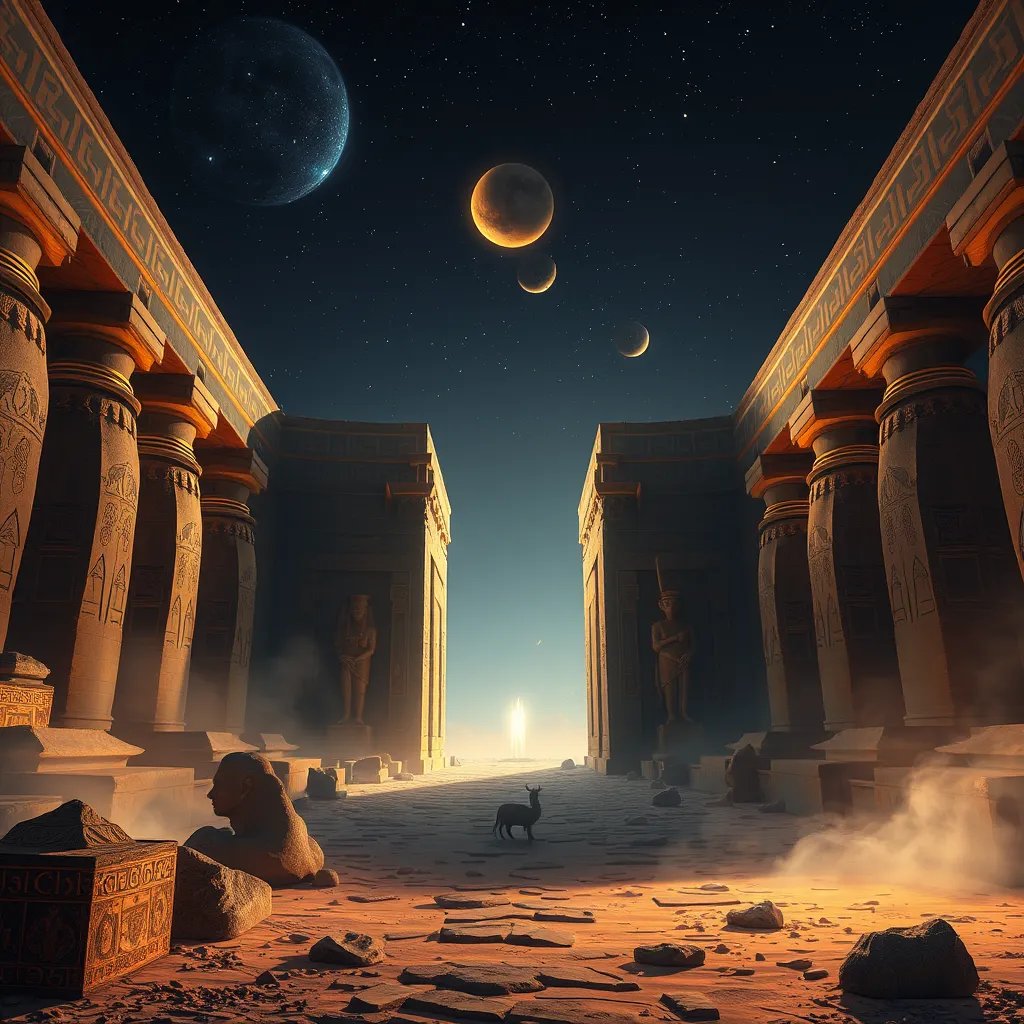The Duat: A Journey Through the Shadows of Time
I. Introduction to the Duat
The Duat, an integral part of ancient Egyptian mythology, refers to the realm of the dead, a mystical underworld where souls embark on a transformative journey after death. This enigmatic place is not merely a destination but a complex landscape filled with trials, deities, and profound significance in the beliefs of the ancient Egyptians.
Understanding the Duat is essential for grasping the ancient Egyptian conception of life, death, and the afterlife. The Duat represents both a physical space and a spiritual journey, guiding souls through the shadows of time and into the afterlife.
II. The Structure of the Duat
The Duat is structured into various realms, each with its own characteristics and challenges. It is often depicted as a vast, dark landscape filled with rivers, mountains, and gates that souls must navigate. Key elements of the Duat’s structure include:
- Rivers: The Nile is often symbolically represented, signifying life and death’s cyclical nature.
- Mountains: These represent obstacles to be overcome, often symbolizing the struggles faced during the journey.
- Gates: Numerous gates serve as checkpoints where souls are judged and must answer questions posed by guardians.
The Duat plays a vital role in the afterlife, serving as a space where the soul undergoes purification and judgment before reaching its final destination, whether eternal life in the Field of Reeds or destruction.
III. The Journey of the Soul
The journey of the soul begins with death, a significant transition marked by intricate rituals and beliefs. Upon passing, the soul is believed to enter the Duat, where it encounters various challenges and figures that guide or hinder its progress.
Key figures in this journey include:
- Osiris: The god of the afterlife and resurrection, Osiris presides over the judgment of souls.
- Anubis: The god of mummification and the protector of graves, Anubis guides the soul through the Duat.
- Isis: The goddess of magic and healing, Isis aids souls in their journey, providing support and protection.
A pivotal moment in this journey is the Weighing of the Heart ceremony, where the deceased’s heart is weighed against the feather of Ma’at, representing truth and justice. This ceremony determines the fate of the soul, establishing whether it is worthy of entering the afterlife or destined for annihilation.
IV. Challenges and Trials in the Duat
As souls traverse the Duat, they encounter various challenges and trials that test their worthiness. Common obstacles include:
- Demons and Creatures: Malevolent beings inhabit the Duat, posing threats to souls and attempting to lead them astray.
- Darkness: The oppressive darkness of the Duat symbolizes ignorance and fear, challenging the soul’s resolve.
- River Crossings: Souls must navigate treacherous waters, often requiring assistance from deities or spells.
The Book of the Dead, a collection of spells and incantations, plays a crucial role in helping souls overcome these trials. It provides guidance, protection, and knowledge necessary for a successful journey through the Duat.
V. The Role of Deities in the Duat
The Duat is populated by numerous gods and goddesses who play essential roles in the journey of the soul. Major deities associated with the Duat include:
- Osiris: As the ruler of the afterlife, he judges the souls of the deceased.
- Anubis: The guide and protector, overseeing the mummification process and ensuring safe passage.
- Thoth: The god of wisdom and writing, who records the outcome of the Weighing of the Heart.
- Ma’at: The goddess of truth, whose feather is used in the judgment process.
These deities embody various aspects of the afterlife, influencing the fate of souls and providing divine intervention during their trials.
VI. Art and Literature Depicting the Duat
The Duat has been vividly represented in ancient Egyptian texts and art. Key sources include:
- Pyramid Texts: The oldest religious texts in the world, inscribed in pyramids, detailing the afterlife journey.
- Coffin Texts: Spells and illustrations found in coffins to aid the deceased in the Duat.
- Artistic Representations: Tomb paintings and carvings depicting scenes from the Duat and the judgment process.
Over time, the depiction of the Duat evolved, reflecting changes in beliefs and artistic styles throughout different periods of ancient Egyptian history.
VII. The Duat in Modern Culture
The influence of the Duat extends into contemporary literature and media, inspiring various interpretations of the afterlife and spirituality. Modern culture often draws parallels between ancient Egyptian beliefs and current views on death and the afterlife. Key points of interest include:
- Literature: Books and novels often incorporate themes of the Duat, exploring the journey of the soul in a modern context.
- Film and Television: Movies and shows frequently reference Egyptian mythology, depicting the Duat and its significance.
- Resurgence of Interest: There is a growing fascination with Egyptian mythology, leading to the revival of ancient beliefs in popular culture.
VIII. Conclusion
In summary, the Duat represents a complex and significant aspect of ancient Egyptian beliefs about the afterlife. From its intricate structure to the challenges faced by souls, understanding the Duat enriches our comprehension of ancient Egyptian culture and spirituality. The legacy of the Duat continues to resonate, influencing modern interpretations of mythology and the afterlife.
As we delve deeper into the mysteries of the Duat, we uncover not only the intricacies of ancient beliefs but also their relevance in today’s world. The exploration of the Duat invites us to reflect on our own beliefs about death, the afterlife, and the journeys that shape our existence.




